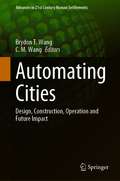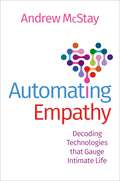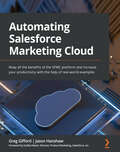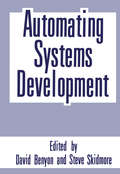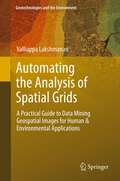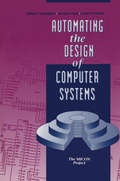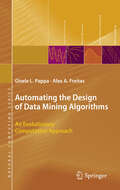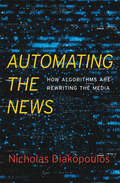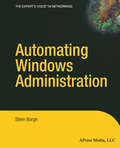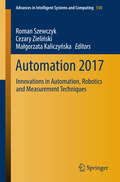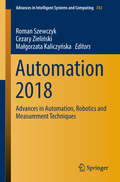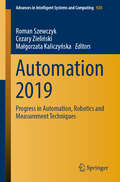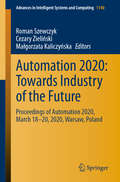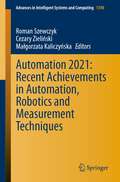- Table View
- List View
Automatically Ordering Events and Times in Text (Studies in Computational Intelligence #677)
by Leon R.A. DerczynskiThe book offers a detailed guide to temporal ordering, exploring open problems in the field and providing solutions and extensive analysis. It addresses the challenge of automatically ordering events and times in text. Aided by TimeML, it also describes and presents concepts relating to time in easy-to-compute terms. Working out the order that events and times happen has proven difficult for computers, since the language used to discuss time can be vague and complex. Mapping out these concepts for a computational system, which does not have its own inherent idea of time, is, unsurprisingly, tough. Solving this problem enables powerful systems that can plan, reason about events, and construct stories of their own accord, as well as understand the complex narratives that humans express and comprehend so naturally. This book presents a theory and data-driven analysis of temporal ordering, leading to the identification of exactly what is difficult about the task. It then proposes and evaluates machine-learning solutions for the major difficulties.It is a valuable resource for those working in machine learning for natural language processing as well as anyone studying time in language, or involved in annotating the structure of time in documents.
Automating Business Modelling: A Guide to Using Logic to Represent Informal Methods and Support Reasoning (Advanced Information and Knowledge Processing)
by Yun-Heh Chen-Burger Dave RobertsonEnhances the use of enterprise models as an effective communication medium between business and technical personnel. Details the blue-print of the to-be developed business system.
Automating Cities: Design, Construction, Operation and Future Impact (Advances in 21st Century Human Settlements)
by Brydon T. Wang C. M. WangThis book highlights the latest advancements in the use of automated systems in the design, construction, operation and future of the built environment and its occupants. It considers how the use of automated decision-making frameworks, artificial intelligence and other technologies of automation are presently impacting the practice of architects, engineers, project managers and contractors, and articulates the near future changes to workflows, legal frameworks and the wider AEC industry. This book surveys and compiles the use of city apps, robots that operate buildings and fabricate structural elements, 3D printing, drones, sensors, algorithms, and advanced prefabricated modules. The book also contributes to the growing literature on smart cities, and explores the impacts on data privacy and data sovereignty that arise through the use of sensors, digital twins and intelligent transport systems. It provides a useful reference for further research and development in the area of automation in design and construction to architects, engineers, project managers, superintendents and construction lawyers, contractors, policy makers, and students.
Automating Empathy: Decoding Technologies that Gauge Intimate Life
by Andrew McStayThis is an open access title. It is made available under a Creative Commons Attribution-Non Commercial-No Derivatives 4.0 International license. It is available to read and download as a PDF version on the Oxford Academic platform. We live in a world where artificial intelligence and intensive use of personal data has become normalized. Companies across the world are developing and launching technologies to infer and interact with emotions, mental states, and human conditions. However, the methods and means of mediating information about people and their emotional states are incomplete and problematic. Automating Empathy offers a critical exploration of technologies that sense intimate dimensions of human life and the modern ethical questions raised by attempts to perform and simulate empathy. It traces the ascendance of empathic technologies from their origins in physiognomy and pathognomy to the modern day and explores technologies in nations with non-Western ethical histories and approaches to emotion, such as Japan. The book examines applications of empathic technologies across sectors such as education, policing, and transportation, and considers key questions of everyday use such as the integration of human-state sensing in mixed reality, the use of neurotechnologies, and the moral limits of using data gleaned through automated empathy. Ultimately, Automating Empathy outlines the key principles necessary to usher in a future where automated empathy can serve and do good. Drawing insights across ethics, philosophy, and policy, Automating Empathy argues for a pluralistic reconceptualization of empathic technologies to better reflect the intimate dimensions of human life.
Automating Empathy: Decoding Technologies that Gauge Intimate Life
by Andrew McStayThis is an open access title. It is made available under a Creative Commons Attribution-Non Commercial-No Derivatives 4.0 International license. It is available to read and download as a PDF version on the Oxford Academic platform. We live in a world where artificial intelligence and intensive use of personal data has become normalized. Companies across the world are developing and launching technologies to infer and interact with emotions, mental states, and human conditions. However, the methods and means of mediating information about people and their emotional states are incomplete and problematic. Automating Empathy offers a critical exploration of technologies that sense intimate dimensions of human life and the modern ethical questions raised by attempts to perform and simulate empathy. It traces the ascendance of empathic technologies from their origins in physiognomy and pathognomy to the modern day and explores technologies in nations with non-Western ethical histories and approaches to emotion, such as Japan. The book examines applications of empathic technologies across sectors such as education, policing, and transportation, and considers key questions of everyday use such as the integration of human-state sensing in mixed reality, the use of neurotechnologies, and the moral limits of using data gleaned through automated empathy. Ultimately, Automating Empathy outlines the key principles necessary to usher in a future where automated empathy can serve and do good. Drawing insights across ethics, philosophy, and policy, Automating Empathy argues for a pluralistic reconceptualization of empathic technologies to better reflect the intimate dimensions of human life.
Automating Instructional Design: Computer-Based Development and Delivery Tools (NATO ASI Subseries F: #140)
by Robert D. Tennyson Ann E. BarronThis institute was organized and presented by an international group of scholars interested in the advancement of instructional design automation through theory, research and applied evaluation. Members of the organizing committee included Dr. Klaus Breuer from disce (Germany), Dr. Jose J. Gonzalez from Agder College of Engineering (Norway), Dr. Begofia Gros from the University of Barcelona, Dr. J. Michael Spector from the Armstrong Laboratory (USA). Dr. Gonzalez, co-director of the institute, and the staff of Agder College were directly responsible for the preparation and operation of the institute in Grimstad, Norway. The institute was held on the campus of Agder College of Engineering, July 12-23, 1993. The theme of the institute extended the initial work developed by the presenters at a NATO Advanced Research Workshop held in Sitges, Spain in 1992. During the two week institute, 21 presentations were made including papers and demonstrations. In addition to the formal presentations, working groups and on-site study groups provided opportunities for the students to participate directly in program activities. An important outcome for the working groups was the formal preparation of their efforts in chapters for this volume.
Automating Instructional Design, Development, and Delivery (NATO ASI Subseries F: #119)
by Robert D. TennysonThis workshop was organized and presented by an international group of scholars interested in the advancement of automating instructional design. Although the principal leader for this effort was myself, each of the committee members devoted equally in time and effort in the total preparation and conducting of the workshop. Members of the organizing committee included Dr. Klaus Breuer from disce and the University ofPaderbom (Germany), Dr. Begofia Gros from the University of Barcelona, and Dr. Daniel Muraida and Dr. Michael Spector from the Armstrong Laboratory (USA). Dr. Gros participated as the co-director of the workshop and was directly responsible for the preparation and operation of the workshop in Sitges, Spain. The workshop was held in Sitges, a short distance from Barcelona, March 23-27, 1992. Because of preparations at that time for the 1992 summer Olympic Games in Barcelona, the workshop was moved to a more convenient location. The theme of the workshop included three main topics: planning, production, and implementation. Dr. Peter Goodyear, from the Lancaster University (England), presented the invited keynote address. During the four day workshop, 14 papers were presented and discussed. Following each of the three topic areas, Drs. Gros and Breuer led discussions critiquing the ideas presented.
Automating Knowledge Acquisition for Expert Systems (The Springer International Series in Engineering and Computer Science #57)
by Sandra MarcusIn June of 1983, our expert systems research group at Carnegie Mellon University began to work actively on automating knowledge acquisition for expert systems. In the last five years, we have developed several tools under the pressure and influence of building expert systems for business and industry. These tools include the five described in chapters 2 through 6 - MORE, MOLE, SALT, KNACK and SIZZLE. One experiment, conducted jointly by developers at Digital Equipment Corporation, the Soar research group at Carnegie Mellon, and members of our group, explored automation of knowledge acquisition and code development for XCON (also known as R1), a production-level expert system for configuring DEC computer systems. This work influenced the development of RIME, a programming methodology developed at Digital which is the subject of chapter 7. This book describes the principles that guided our work, looks in detail at the design and operation of each tool or methodology, and reports some lessons learned from the enterprise. of the work, brought out in the introductory chapter, is A common theme that much power can be gained by understanding the roles that domain knowledge plays in problem solving. Each tool can exploit such an understanding because it focuses on a well defined problem-solving method used by the expert systems it builds. Each tool chapter describes the basic problem-solving method assumed by the tool and the leverage provided by committing to the method.
Automating Linguistics (History of Computing)
by Jacqueline LéonAutomating Linguistics offers an in-depth study of the history of the mathematisation and automation of the sciences of language. In the wake of the first mathematisation of the 1930s, two waves followed: machine translation in the 1950s and the development of computational linguistics and natural language processing in the 1960s. These waves were pivotal given the work of large computerised corpora in the 1990s and the unprecedented technological development of computers and software.Early machine translation was devised as a war technology originating in the sciences of war, amidst the amalgamate of mathematics, physics, logics, neurosciences, acoustics, and emerging sciences such as cybernetics and information theory. Machine translation was intended to provide mass translations for strategic purposes during the Cold War. Linguistics, in turn, did not belong to the sciences of war, and played a minor role in the pioneering projects of machine translation.Comparing the two trends, the present book reveals how the sciences of language gradually integrated the technologies of computing and software, resulting in the second-wave mathematisation of the study of language, which may be called mathematisation-automation. The integration took on various shapes contingent upon cultural and linguistic traditions (USA, ex-USSR, Great Britain and France). By contrast, working with large corpora in the 1990s, though enabled by unprecedented development of computing and software, was primarily a continuation of traditional approaches in the sciences of language sciences, such as the study of spoken and written texts, lexicography, and statistical studies of vocabulary.
Automating Linux and Unix System Administration
by Nathan Campi Kirk BauerThe author focuses solely on how UNIX and Linux system administrators can use well-known tools to automate tasks, even across multiple systems.
Automating Microsoft Azure with PowerShell
by John Chapman Aman DhallyThis book is designed to help administrators and developers better automate Azure management tasks. No prior knowledge of PowerShell is required.
Automating Open Source Intelligence: Algorithms for OSINT
by Robert Layton Paul A WattersAlgorithms for Automating Open Source Intelligence (OSINT) presents information on the gathering of information and extraction of actionable intelligence from openly available sources, including news broadcasts, public repositories, and more recently, social media. As OSINT has applications in crime fighting, state-based intelligence, and social research, this book provides recent advances in text mining, web crawling, and other algorithms that have led to advances in methods that can largely automate this process. The book is beneficial to both practitioners and academic researchers, with discussions of the latest advances in applications, a coherent set of methods and processes for automating OSINT, and interdisciplinary perspectives on the key problems identified within each discipline. Drawing upon years of practical experience and using numerous examples, editors Robert Layton, Paul Watters, and a distinguished list of contributors discuss Evidence Accumulation Strategies for OSINT, Named Entity Resolution in Social Media, Analyzing Social Media Campaigns for Group Size Estimation, Surveys and qualitative techniques in OSINT, and Geospatial reasoning of open data. Presents a coherent set of methods and processes for automating OSINTFocuses on algorithms and applications allowing the practitioner to get up and running quicklyIncludes fully developed case studies on the digital underground and predicting crime through OSINTDiscusses the ethical considerations when using publicly available online data
Automating Salesforce Marketing Cloud: Reap all the benefits of the SFMC platform and increase your productivity with the help of real-world examples
by Greg Gifford Jason Hanshaw Guilda HilaireMake the most of Salesforce Marketing Cloud through automation and increase your productivity on the platform without adding any extra resourcesKey FeaturesIncrease your knowledge of automation theory and the applications of SFMCExplore automation with SFMC and its capabilities beyond general usageUnderstand the automation features and integrations of SFMC to use the platform from outside the user interface (UI) for maximum efficiencyBook DescriptionSalesforce Marketing Cloud (SFMC) allows you to use multiple channels and tools to create a 1:1 marketing experience for your customers and subscribers. Through automation and helper tasks, you can greatly increase your productivity while also reducing the level of effort required in terms of volume and frequency.Automating Salesforce Marketing Cloud starts by discussing what automation is generally and then progresses to what automation is in SFMC. After that, you'll focus on how to perform automation inside of SFMC all the way to fully running processes and capabilities from an external service. Later chapters explore the benefits and capabilities of automation and having an automation mindset both within and outside of SFMC. Equipped with this knowledge and example code, you'll be prepared to maximize your SFMC efficiency.By the end of this Salesforce book, you'll have the skills you need to build automation both inside and outside of SFMC, along with the knowledge for using the platform optimally.What you will learnUnderstand automation to make the most of the SFMC platformOptimize ETL activities, data import integrations, data segmentations, email sends, and moreExplore different ways to use scripting and API calls to increase Automation Studio efficiencyIdentify opportunities for automation with custom integrations and third-party solutionsOptimize usage of SFMC by building on the core concepts of custom integrations and third-party toolsMaximize utilization of employee skills and capabilities and reduce operational costs while increasing outputWho this book is forThis book is for Salesforce Marketing Cloud users who want to know how to make their day to day lives more efficient and get the most out of the tool by working smarter, not harder. A solid understanding of SFMC and basic knowledge of what automation is will help you get the most out of this book.
Automating Security Detection Engineering: A hands-on guide to implementing Detection as Code
by Dennis ChowAccelerate security detection development with AI-enabled technical solutions using threat-informed defenseKey FeaturesCreate automated CI/CD pipelines for testing and implementing threat detection use casesApply implementation strategies to optimize the adoption of automated work streamsUse a variety of enterprise-grade tools and APIs to bolster your detection programPurchase of the print or Kindle book includes a free PDF eBookBook DescriptionToday's global enterprise security programs grapple with constantly evolving threats. Even though the industry has released abundant security tools, most of which are equipped with APIs for integrations, they lack a rapid detection development work stream. This book arms you with the skills you need to automate the development, testing, and monitoring of detection-based use cases. You’ll start with the technical architecture, exploring where automation is conducive throughout the detection use case lifecycle. With the help of hands-on labs, you’ll learn how to utilize threat-informed defense artifacts and then progress to creating advanced AI-powered CI/CD pipelines to bolster your Detection as Code practices. Along the way, you'll develop custom code for EDRs, WAFs, SIEMs, CSPMs, RASPs, and NIDS. The book will also guide you in developing KPIs for program monitoring and cover collaboration mechanisms to operate the team with DevSecOps principles. Finally, you'll be able to customize a Detection as Code program that fits your organization's needs. By the end of the book, you'll have gained the expertise to automate nearly the entire use case development lifecycle for any enterprise.What you will learnUnderstand the architecture of Detection as Code implementationsDevelop custom test functions using Python and TerraformLeverage common tools like GitHub and Python 3.x to create detection-focused CI/CD pipelinesIntegrate cutting-edge technology and operational patterns to further refine program efficacyApply monitoring techniques to continuously assess use case healthCreate, structure, and commit detections to a code repositoryWho this book is forThis book is for security engineers and analysts responsible for the day-to-day tasks of developing and implementing new detections at scale. If you’re working with existing programs focused on threat detection, you’ll also find this book helpful. Prior knowledge of DevSecOps, hands-on experience with any programming or scripting languages, and familiarity with common security practices and tools are recommended for an optimal learning experience.
Automating Systems Development
by David R. Benyon Steve Skidmore1 INTRODUCTION These proceedings are the result of a conference on Automating Systems Development held at Leicester Polytechnic, England on 14 to 16 April 1987. The conference was attended by over 170 delegates from industry and academia and it represents a comprehensive review of the state of the art of the use of the computer based tools for the analysis, design and construction of Information Systems (IS). Two parallel streams ran throughout the conference. The academic, or research, papers were the fruit of British, European and Canadian research, with some of the papers reflecting UK Government funded Alvey or European ESPRIT research projects. Two important touchstones guided the selection of academic papers. Firstly, they should be primarily concerned with system, rather than program, development. Secondly, they should be easily accessible to delegates and readers. We felt that formal mathematical papers had plenty of other opportunities for airing and publication. The second stream was the applied programme; a set of formal presentations given by leading software vendors and consultancies. It is clear that many advances in systems development are actually applied, rather than re search led. Thus it was important for delegates to hear how leading edge companies view the State of the Art. This was supported by a small exhibi tion area where certain vendors demonstrated the software they had intro duced in the formal presentation.
Automating the Analysis of Spatial Grids: A Practical Guide to Data Mining Geospatial Images for Human & Environmental Applications (Geotechnologies and the Environment #6)
by Valliappa LakshmananThe ability to create automated algorithms to process gridded spatial data is increasingly important as remotely sensed datasets increase in volume and frequency. Whether in business, social science, ecology, meteorology or urban planning, the ability to create automated applications to analyze and detect patterns in geospatial data is increasingly important. This book provides students with a foundation in topics of digital image processing and data mining as applied to geospatial datasets. The aim is for readers to be able to devise and implement automated techniques to extract information from spatial grids such as radar, satellite or high-resolution survey imagery.
Automating the Design of Computer Systems
by William P. Birmingham Anurag P. Gupta Daniel P. SiewiorekAddressing the issues of engineering design in computer architecture, this book describes the design and implementation of MICON, a system for automating the synthesis of small computers.
Automating the Design of Data Mining Algorithms: An Evolutionary Computation Approach (Natural Computing Series)
by Gisele L. Pappa Alex FreitasData mining is a very active research area with many successful real-world app- cations. It consists of a set of concepts and methods used to extract interesting or useful knowledge (or patterns) from real-world datasets, providing valuable support for decision making in industry, business, government, and science. Although there are already many types of data mining algorithms available in the literature, it is still dif cult for users to choose the best possible data mining algorithm for their particular data mining problem. In addition, data mining al- rithms have been manually designed; therefore they incorporate human biases and preferences. This book proposes a new approach to the design of data mining algorithms. - stead of relying on the slow and ad hoc process of manual algorithm design, this book proposes systematically automating the design of data mining algorithms with an evolutionary computation approach. More precisely, we propose a genetic p- gramming system (a type of evolutionary computation method that evolves c- puter programs) to automate the design of rule induction algorithms, a type of cl- si cation method that discovers a set of classi cation rules from data. We focus on genetic programming in this book because it is the paradigmatic type of machine learning method for automating the generation of programs and because it has the advantage of performing a global search in the space of candidate solutions (data mining algorithms in our case), but in principle other types of search methods for this task could be investigated in the future.
Automating the News: How Algorithms Are Rewriting the Media
by Nicholas DiakopoulosFrom hidden connections in big data to bots spreading fake news, journalism is increasingly computer-generated. Nicholas Diakopoulos explains the present and future of a world in which algorithms have changed how the news is created, disseminated, and received, and he shows why journalists—and their values—are at little risk of being replaced.
Automating Windows Administration
by Stein Borge* Covers common administration tasks for Exchange 5.5, Exchange 2000, Exchange 2003, Internet Information Server (IIS) 4 and 5 and 6, and Windows NT 4, 2000, XP and Windows 2003. * Extensive examples using Windows Management Instrumentation (WMI), which provides registry, network/system administrative, and security operations. * This book is the analog of the tools that were used in our very successful book, ISBN 1590592123 Automating UNIX and Linux Administration (Apress, 2003) for similar tasks.
Automation 2017: Innovations in Automation, Robotics and Measurement Techniques (Advances in Intelligent Systems and Computing #550)
by Roman Szewczyk Cezary Zieliński Małgorzata KaliczyńskaThis book consists of papers presented at Automation 2017, an international conference held in Warsaw from March 15 to 17, 2017. It discusses research findings associated with the concepts behind INDUSTRY 4.0, with a focus on offering a better understanding of and promoting participation in the Fourth Industrial Revolution. Each chapter presents a detailed analysis of a specific technical problem, in most cases followed by a numerical analysis, simulation and description of the results of implementing the solution in a real-world context. The theoretical results, practical solutions and guidelines presented are valuable for both researchers working in the area of engineering sciences and practitioners looking for solutions to industrial problems.
Automation 2018: Advances in Automation, Robotics and Measurement Techniques (Advances in Intelligent Systems and Computing #743)
by Roman Szewczyk Cezary Zieliński Małgorzata KaliczyńskaThis book consists of papers presented at Automation 2018, an international conference held in Warsaw from March 21 to 23, 2018. It discusses the radical technological changes occurring due to the INDUSTRY 4.0, with a focus on offering a better understanding of the Fourth Industrial Revolution. Each chapter presents a detailed analysis of interdisciplinary knowledge, numerical modeling and simulation as well as the application of cyber-physical systems, where information technology and physical devices create synergic systems leading to unprecedented efficiency. The theoretical results, practical solutions and guidelines presented are valuable for both researchers working in the area of engineering sciences and practitioners looking for solutions to industrial problems.
Automation 2019: Progress in Automation, Robotics and Measurement Techniques (Advances in Intelligent Systems and Computing #920)
by Roman Szewczyk Cezary Zieliński Małgorzata KaliczyńskaThis book consists of papers presented at AUTOMATION2019, an international conference held in Warsaw from March 27 to 29, 2019. It discusses the radical technological changes occurring due to the INDUSTRY 4.0. To follow these changes, both scientists and engineers have to face the challenge of interdisciplinary approach directed at the development of cyber-physical systems. This approach encompasses interdisciplinary theoretical knowledge, numerical modelling and simulation as well as application of artificial intelligence techniques. Both software and physical devices are composed into systems that will increase production efficiency and resource savings. The theoretical results, practical solutions and guidelines presented are valuable for both researchers working in the area of engineering sciences and practitioners looking for solutions to industrial problems.
Automation 2020: Proceedings of Automation 2020, March 18–20, 2020, Warsaw, Poland (Advances in Intelligent Systems and Computing #1140)
by Roman Szewczyk Cezary Zieliński Małgorzata KaliczyńskaThis book presents the scientific outcomes of the International Conference AUTOMATION 2020, held on March 18–20, 2020 in Warsaw, Poland. The next 30 years will see radical innovations in production processes, transportation management and social life. The changes brought about by the transformation to zero-emission industry require advances in many fields, but especially in industrial automation, robotics and measurement techniques associated with the cyber-physical systems employing artificial intelligence that will be key to reducing costs and enabling European society to maintain its quality of live. In this context, the book features the latest research toward further developing these fields of engineering, and also offers solutions and guidelines that are useful for both researchers and engineers addressing problems associated with the world of ongoing radical changes.
Automation 2021: Recent Achievements in Automation, Robotics and Measurement Techniques (Advances in Intelligent Systems and Computing #1390)
by Roman Szewczyk Cezary Zieliński Małgorzata KaliczyńskaThis book contains 38 papers authored by both scientists and practitioners focused on an interdisciplinary approach to the development of cyber-physical systems. Recently our civilization has been facing one of the most severe challenges in modern history. The COVID-19 pandemic devastated the global economy and significantly disrupted numerous areas of economic activity. Only radical increase of efficiency and versatility of industrial production, with further limitation of human involvement, paralleled by the decrease of environmental burden, will enable us to cope with such challenges. We hope that the presented book provides input to the solution of at least some problems brought about by this challenge. This approach relies on the development of measuring techniques, robotic and mechatronic systems, industrial automation, numerical modeling and simulation as well as application of artificial intelligence techniques required by the transformation leading to Industry 4.0.


